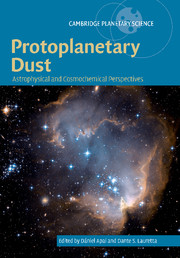Book contents
- Frontmatter
- Contents
- List of contributing authors
- Preface
- Acknowledgments
- 1 Planet formation and protoplanetary dust
- 2 The origins of protoplanetary dust and the formation of accretion disks
- 3 Evolution of protoplanetary disk structures
- 4 Chemical and isotopic evolution of the solar nebula and protoplanetary disks
- 5 Laboratory studies of simple dust analogs in astrophysical environments
- 6 Dust composition in protoplanetary disks
- 7 Dust particle size evolution
- 8 Thermal processing in protoplanetary nebulae
- 9 The clearing of protoplanetary disks and of the proto-solar nebula
- 10 Accretion of planetesimals and the formation of rocky planets
- Appendix 1 Common minerals in the Solar System
- Appendix 2 Mass spectrometry
- Appendix 3 Basics of light absorption and scattering theory
- Glossary
- Index
7 - Dust particle size evolution
Published online by Cambridge University Press: 24 February 2010
- Frontmatter
- Contents
- List of contributing authors
- Preface
- Acknowledgments
- 1 Planet formation and protoplanetary dust
- 2 The origins of protoplanetary dust and the formation of accretion disks
- 3 Evolution of protoplanetary disk structures
- 4 Chemical and isotopic evolution of the solar nebula and protoplanetary disks
- 5 Laboratory studies of simple dust analogs in astrophysical environments
- 6 Dust composition in protoplanetary disks
- 7 Dust particle size evolution
- 8 Thermal processing in protoplanetary nebulae
- 9 The clearing of protoplanetary disks and of the proto-solar nebula
- 10 Accretion of planetesimals and the formation of rocky planets
- Appendix 1 Common minerals in the Solar System
- Appendix 2 Mass spectrometry
- Appendix 3 Basics of light absorption and scattering theory
- Glossary
- Index
Summary
Abstract This chapter describes how the growth of particles from submicron to centimeter sizes in protoplanetary disks is chronicled both by astronomical observations and microscopic imaging of pristine meteoritic material. A growing sample of planet-forming disks at a range of evolutionary stages is available for astronomical remote sensing studies, but limitations of spatial resolution as well as very high optical depths still hide the inner mid-plane of the disks – the exact region where planets are believed to form. Conversely, meteoritic studies currently exclusively sample material from the inner mid-plane of the solar nebula, and the fact that such material can be brought into a laboratory setting allows very detailed studies of its properties. The dust component in the matrices of chondritic meteorites carries a record of continuous processing and modification of fine-grained material during protoplanetary disk evolution that tends to obscure the earliest stages of dust formation, growth, and coagulation. We discuss how knowledge on dust particle size evolution gained from these two very different approaches can be combined to significantly enhance our understanding of the first stages in planet formation.
Solids in protoplanetary disks undergo a growth process resulting in extreme changes in the size distribution of dust particles over time. We know this because the particle size distribution of dust in the interstellar medium (ISM) is so different from that of planets, leftover planetesimals, and dust in our own Solar System; the formation of the Earth from submicron grains corresponds to a change of 12 orders of magnitude! The presence of a large number of extrasolar planets shows that the planet-formation process is relatively common.
- Type
- Chapter
- Information
- Protoplanetary DustAstrophysical and Cosmochemical Perspectives, pp. 191 - 229Publisher: Cambridge University PressPrint publication year: 2010
- 10
- Cited by

